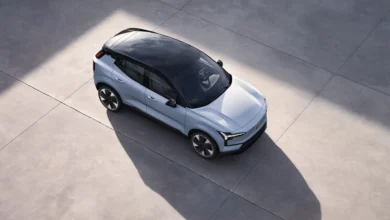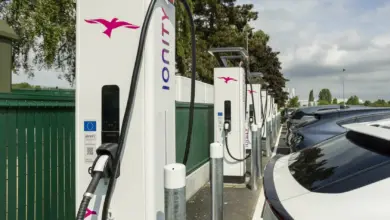Sam Hunt Is Ready For The NASCAR Xfinity Challenge


Not long ago, NASCAR Xfinity Series team owner Sam Hunt was living out of his van outside an engine shop in Charlotte, North Carolina, hoping he’d manage to transform his fledgling race team into something great. In 2021, the team scored an unprecedented third-place finish at Richmond Raceway during its first full-time season. That’s a pretty massive change in the blink of an eye.
Put it down to Hunt’s down-to-earth tenacity. In a recent conversation with Jalopnik, Hunt credited his dedicated crew for the team’s success — and hopes that, above all else, people remember him as someone who gave them a chance.
This year, SHR is running yet another full-time schedule with drivers Ryan Truex, Jeffrey Earnhardt, and John Hunter Nemecheck, and things have looked good so far. Earnhardt scored a 15th-place finish at Daytona while Truex took 12th. In Fontana last weekend, Earnhardt finished 29th — and things are looking good for Nemecheck’s debut in Las Vegas.
Elizabeth Blackstock: What made you decide to go from being a team owner? Or from being a driver to becoming a team owner?
Sam Hunt: I think reality was a huge part of it for me. I raced my whole life, grew up overseas, started karting in the Netherlands when I was four or five, and it was all I knew and all I wanted to do. Came to the States, did late model racing, had my own K&N cars that I drove for a while. And I just came to the reality of, “Hey, I can’t afford to keep pushing at this level.”
We were doing everything we could, scraping sponsors together to just keep me in the seat, at a very mid-tier level. And then, I was fortunate enough to have raced in the same K&N class as Kyle Larson and Chase Elliot — a lot of guys that are racing on Sundays now. So in a strange way, it was good for me because I saw Kyle… I used Larson as such a great example. Because even, when we were 16 or 18 racing the East cars, we all vividly remember him coming in, nobody knowing who he was but being like, “This kid’s a robot, he’s so good. He’s got something that we don’t have.”
So I knew — or maybe for the first time saw — the talent that it took to make it on your own.
I had mentors, whether it be back home or close by, like the late J. D. Gibbs who, and I went to them and was like, “What do I do with my life? I’ve wanted to be a race car driver for so long, and now I’m at this crossroads.”
And it was actually [Gibbs’] advice to go to college, which was the last thing a racer wants to do.
So I went to VCU, Virginia Commonwealth for four years, studied finance. Once I finished that, J. D. and a couple other people got me a couple of old K&N cars and a little bit of equipment to start a small business. That was that I wanted to do. I wanted to still stay in racing.
I had some corporate jobs lined up through school and actually me and my now wife joke about it, because we had just met and it was like, “Maybe we should try this thing or I should try this thing. It’ll probably burn up before it ever gets going, but I need to at least try.”
And so we went into it with that ‘nothing to lose’ mentality. And here we are four years later, full-time Xfinity racing.
EB: You’ve said in the past that founding a team has been a brick by brick process, and it took a lot of your own personal life savings to get this team on track. I can imagine that there were a lot of personal and professional setbacks. What kept you pushing through, what kept you motivated?
SH: One of the big bricks to what made this company what it is are really great people inside the motorsport industry that had no obligation or reason to help me or to help what I was trying to do but did anyways.
When I moved the team to North Carolina, because that’s where we had to be, the Robert Yates Engine Shop took me in. They were like, “Hey, take a corner of our building for your two cars. Don’t pay us a dime. We just want to help.”
It was like I’d meet these people in the sport that saw what I was trying to do and loved what I was trying to do and would give me that next bread crumb to keep going. So I think through the adversity, it was like wanting to do it for people other than myself is really what kept me going.
EB: And I was going to ask — you’re working in an industry where you have a lot of people that you know, that you’re friends with. How has that contributed to the growth of the team?
SH: I think it’s been a big part of it. We just ran Daytona with Ryan Truex, who’s one of my best friends — and his dog, we’re actually babysitting right now. It’s trying to break into this little office.
But I’ve got so many perspectives from industry folk, a lot of which are your friends. And I think having friends that I’m working with, you get more of an honest answer or opinion on what you’re doing. There’s not really like an ulterior motive. When you’re asking for advice, it’s people that you trust and you love, that want to see you succeed and aren’t trying to gain something from us or take advantage of us. It’s been a huge help having so many friends racing on Sundays or racing with us, or people that have helped out, because it is an interesting business, and you’ve got to be really careful how you navigate everything.
EB: And you’re so young too. What has it been like to find success at that age and to be taking on a pretty big challenge?
SH: I definitely don’t feel young. I feel like I’m aging at light speed, doing this. I really don’t think about it too much.
It’s funny. I was on pit road before Saturday’s race at Daytona, and my mom was able to come down from Virginia. She’s not at many [races], so it was the first time I ever had her on pit road with me. The National Anthem and everything was going, and she’s like, “Do you ever pinch yourself and realize that you’re doing a great thing here?”
It caught me off guard, because I’m so laser-focused on what I’m doing or what’s next or how we can improve that I never really have stepped back and just seen that we’ve created a beautiful thing that’s still blossoming. And, that was maybe the first time.
Since then, I’ve taken a second and really just enjoyed where I was at and looked at the people that work for me and seeing smiles on their faces and that I’m able to provide for them and their families. Because that’s where I get my fulfillment — helping people. And the further we push this thing, the more people I can help and the happier I am.
EB: Did it take a big mindset shift to go from being a driver, which… it’s not a selfish thing, but you are a little bit more involved in your own program, to then be thinking about taking care of all these other people?
SH: Yeah, for me it was like, if I’m racing, it’s all me. The back of my mind is always going to be focused on my racing. Because I got the question a lot, “Why don’t you still race a little bit and then run the team or try to do both?
I miss racing to death, but I was like, “If I’m going to commit to this side of the sport, I need to be all in and just fully commit.” So, that was the transition decision. I’d love to race something at some point again one day, even if it’s a street stock at the local quarter mile. It doesn’t matter to me.
But it’s tough, because I don’t really have time to think about driving anymore, and I’m so committed and honestly maybe even a little happier in my role now.
I think so many of us, we grow up these aspiring race car drivers. And you put all of your happiness in this basket of, “I have to make it or else I’m a failure or everybody’s going to see me as a failure. I’m not going to be happy.”
I remember feeling that pressure and now the fulfillment of having or leading these great people that work for me, giving guys a chance, like Derek Griffith who is a younger, late model star that we’ve got signed for this year. Giving these other hard working kids opportunity that we all dream of, is almost more enjoyable than being in the driver’s seat. So, I’m more happy now, in my role, than I even was as a race car driver.
EB: Did you expect the team to take off as quickly as it did?
SH: Not at all. Like I said, I get the question a lot, “What’s the five-year, 10-year plan for your company?” And I’m like, “Shoot, when this started I was like, I don’t know if this thing will be here a month from now. I’m just a dumb college graduate with a pipe dream.”
So no, I never expected the success we’ve had, and all the credit goes to the people that I mentioned that have helped or bought into this thing, that have way more experience and way more success than I’ve had and might ever have.
My name is on the team and my initials are on the logo, but it represents a lot of the good people in the industry. And that’s what I’m most proud about.
EB: And you say you’re not really thinking about the longer term plans, but what would your hope be? If you could have anything in the world, where would you be five years from now?
SH: It’s changed a lot. It used to be for me, I need to be in this series or I need to be doing something specific. Now, a year or two ago and my motive truly changed to wanting to help people, as corny as that sounds. But, rather than chasing something tangible, I’ve just enjoyed this way more.
So, obviously I’d love to be Cup racing at some point, whether it’s once or for 10 years. I think it’d just be cool to race at the pinnacle of our sport. But, if I’ve got good people working with me and that I’m around every day and we can compete, whether it’s Cup, Xfinity, Trucks — it doesn’t matter to me. If we’ve got a building full of happy people, that’s the one for us.
EB: And you’ve focused on having, in the past, drivers who are a little bit younger and there’s been… I don’t want to say a revolving door, but there’s been quite a few drivers that have come in. What was the reasoning behind that? And how was that impact to the team?
SH: Yeah, no. It’s got its challenges, but to me it’s really cool because I get to give opportunities to more than one guy a year. As we all know, the sport is just so expensive, and it takes so much sponsorship to break in at this level, that we serve as an opportunity for guys that don’t have full budgets or don’t have the sponsorship to run 33 races but they still want an opportunity to show their skillset or show what they’re capable of.
So I think it’s challenge, having so many different guys get into the seat on the team and the communication side. But at the same time, it’s cool being able to work with so many different young guys and their backgrounds and their sponsors or family. And again, relationship is my favorite part of this. So as it looks, the more the merrier.
EB: You also have the younger, more inexperienced guys contrasted with someone like Ryan Truex, who has a lot of experience. What do the veterans offer that helps bolster the team?
SH: Yeah. John Hunter last year was huge. I used him as the example because like Richmond, we almost won the Richmond race and finished third with John Hunter. And his experience really showed, compared to some of the other guys. Not that there was anything wrong. Like Santino Ferucci hopped in and ran really good, but he just didn’t know what he didn’t know, because he’d never driven anything but open wheel.
So when your John Hunters or Ryan [Truex]s get in, they just bring feedback to the team that we don’t get every week. And even Jeffrey Earnhardt now, he’s got plenty of experience. The struggle with the younger guys is we don’t always know where we’re at, with the race cars or with the team.
And then when a John Hunter or Jeffrey or Ryan get in, there’s a more clear communication on where we need to improve, whether we do or we don’t. One of John Hunter’s big roles with our team is to get in the car and evaluate the car, the team, how everybody works. It’s funny, because he is considered a veteran and he’s 24 years old, but that’s just the time we live in now. But it’s a huge help to the team, because none of us have egos and nobody, in our organization, thinks we have it all figured out. Everybody’s super open-minded and just wanting to improve.
EB: You guys have taken a real fun approach to PR, like that super up close cell phone video that you did at Daytona was incredible. Why go with that approach? What does that give you in contrast to the more standard traditional PR?
SH: Yeah. I just think we’ve got great people that work on that stuff for us, but the social side and how we present ourself doesn’t cost much. In the grand scheme of what operating costs, it doesn’t cost that much more to try and be the best at our social or marketing or how we present ourself.
I think we’ve always wanted to be very relatable to the everyday person because in reality, that’s all we are and that’s what we came from. And I think there’s just a lot of the same content getting pushed out all of the time in NASCAR or really any form of motor sports to where it gets to be too much, and it’s all the same. We don’t really pretend to be the tough guys that everybody else asks or wants to be. We’re just normal people like everybody on the other side of the screen, and if we’re not having fun, why are we even doing it?
EB: So far, what’s been the moment of your career that stands out from the rest, that you are the most proud of?
SH: We were running third at Richmond last year, which is our home. Richmond’s where I went to school. That’s where a lot of my childhood was. So, having a huge home crowd there and having a company career run, last year, was really special and a sentimental moment for me, because that’s where I saw my first NASCAR race.
That’s where I fell in love with the sport. So, as much as we wanted to win that race, for our smaller team to run inside the top five and compete, was really special. So, that’s probably the best to date. I know, even our first race as a team, when we started the K&N deal and I had no idea what I was doing. Not that I really have any idea what I’m doing now, but at that point I was fresh out of college.
EB: Yeah. Just a shot in the dark.
SH: Just pretending to have confidence. And we ended up having a really good race, and I blame that race as fooling me into thinking we can do this and just charging forward with it. But, as far as the Xfinity team and racing at this level, Richmond was a really special weekend last year.
EB: Since COVID has taken a backseat and fans are at the track again, there’s been so much talk about what the fans offer to people on the track. Do you think it helped being at your home track in Richmond? Do you think that gave you that feeling that you needed to boost you just that little bit more to that third place?
SH: Yeah, for sure. We had… it was probably over a hundred supporters of the team or friends of mine or family. Having the fans back in the crowd in general just creates a buzz. I got in at a weird time, because 2020, we finally got to where we’re racing the Xfinity series, and we’re pushing the car out at Indy, and it’s just empty. And it’s like, “Man, this isn’t really what I expected at this level.”
But then, Daytona, this past weekend was absolutely packed, even on Saturday. You couldn’t get anywhere, the drivers couldn’t get anywhere, because they’re signing autographs the whole time. And the garage has tons of fans and sponsors in it and it’s almost like this rejuvenated feeling to where, “NASCAR’s back!” And I think when there weren’t fans, it was like, “Are people going to come back when it opens back up, or has everybody gotten used to the COVID protocol?” So, it was really cool to see such a great crowd of people at Daytona. I think it’s got us all motivated.
EB: I know it’s early, but 30 years from now, what do you hope your legacy will be?
SH: Honestly, I hope it’s that I was able to help a lot of people and change a lot of lives. If I never win a race but I changed lives, and I’m able to help people like so many have helped me even get to this point, I’ll be as happy as I ever could be.
Some people interpret that as I’m not 200 percent in or I’m not do-or-die because I am competitive and I always have been my entire life. But, the highs come and go, and it’s such a wave that I just want people to be able to look at me and say, “That guy helped me along the way and in my career.” Or, “He was a good friend to me when we worked with each other, and we still talk to each other.”
Because, I think that’s all that really matters. And it sounds corny every time I talk about it, but it’s the truth, and I’m in a really good place right now.
EB: Yeah. I was going to say, I’ve talked to a lot of younger drivers or people trying to get into this sport. And those are the people they point to the most, are the people who just offered kind words or were nice or handed them a broom and was like, “Go do something in the shop and just get used to it.” So, I think that’s the way to go.
SH: I can’t emphasize the amount of people that have helped Sam Hunt Racing become what it is. And they’ve got no public recognition, or nobody really knows how. But at some point, whether it’s a book or something, there’s so many people I want to give back to one day.
Or at least do the same thing that they’ve done for me, because like I said, “It’s a special place and a lot of really special people have helped build it.”
EB: My last question, what’s your daily driver?
SH: It is a two thousand — I swear I actually know the year — Toyota Tacoma. So nothing flashy. It needs to be cleaned out. The oil probably needs to be changed. But yeah, I’ve never owned a fast car, personally.
EB: Who needs ‘em?
SH: Yeah, I’ve looked at the Supras, and the problem with the Supra, as cool as it is — we’ve got a dog, and we’re always carrying so much stuff… I’m becoming such an old practical man for my age. Practicality is so much more important than what’s cool or what’s going to be the most fun.
Sometimes I need to catch myself from aging too fast because like you said, I’m still young and want to make sure I enjoy my life.
EB: But practical is still good. You can still have a lot of fun in a Tacoma.
SH: Yeah. Yeah. It’s funny, like going to bed at like nine o’clock, or whenever I do get to go to bed at a decent hour, it’s the happiest I am. I get in bed and I’m like, “I’m so happy right now.”
I never thought I’d grow up and be excited about going to bed early. But, it’s just funny how life changes. Yeah, for sure. For sure.
EB: Thank you so much for taking the time today, I really appreciate it. And I wish you good luck the rest of the weekend.




